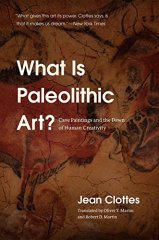What is Paleolithic Art?
689,66 TL
Kategori
Yayınevi
Barkod
9780226266633
Yazar
Clottes, Jean
Yayın Dili
İngilizce
Yayın Yılı
2016
Sayfa Sayısı
192
Kapak Tipi
Karton Kapak
Piyasa Fiyatı
18 USD
Was it a trick of the light that drew our Stone Age ancestors into caves to paint in charcoal and red hematite, to watch the heads of lions, likenesses of bison, horses, and aurochs in the reliefs of the walls, as they flickered by firelight? Or was it something deeper--a creative impulse, a spiritual dawn, a shamanistic conception of the world efflorescing in the dark, dank spaces beneath the surface of the earth where the spirits were literally at hand?
In this book, Jean Clottes, one of the most renowned figures in the study of cave paintings, pursues an answer to this "why" of Paleolithic art. While other books focus on particular sites and surveys, Clottes's work is a contemplative journey across the world, a personal reflection on how we have viewed these paintings in the past, what we learn from looking at them across geographies, and what these paintings may have meant--what function they may have served--for their artists. Steeped in Clottes's shamanistic theories of cave painting, What Is Paleolithic Art? travels from well-known Ice Age sites like Chauvet, Altamira, and Lascaux to visits with contemporary aboriginal artists, evoking a continuum between the cave paintings of our prehistoric past and the living rock art of today. Clottes's work lifts us from the darkness of our Paleolithic origins to reveal, by firelight, how we think, why we create, why we believe, and who we are.
Review: "Clottes is the leading Paleolithic archaeologist and perhaps the most famous archaeologist in the world. This alone makes What Is Paleolithic Art? noteworthy. But the topic is also one that generates interest beyond the archaeological profession, especially inasmuch as his expansive discussion emphasizes shamanism as the likely origin for this art, and partly bases this conclusion on comparisons and analogies with ethnographic cases. . . . Very readable and appealing."--David S. Whitley, author of Cave Paintings and the Human Spirit: The Origin of Creativity and Belief "Chicago Tribune, Printers Row"
"Clottes's Pourquoi l'art prehistorique? has at long last been translated into English. . . . In this latest offering he tackles the question of 'why' not just 'what.' This is a great leap for most archaeologists, who prefer to describe what they can see and hold in their hands, rather than the nebulous realms of dreams and thoughts behind the works. Stepping beyond the traditional realm of archaeology, Clottes takes the reader on a worldwide journey from well-known Ice Age sites such as Chauvet and Lascaux to the work of contemporary aboriginal artists, tracing some of the earliest examples of human creativity in the shamanistic tradition of Homo spiritualis (man the spiritual being) rather than homo faber (man the toolmaker). Though not all readers will agree with the author's interpretation of the shamanistic art of rock art, the theory is credible. This readable and appealing translation is a must for those serious about archaeology or art history. Essential."--A. Wirkkala, NHTI, Concord's Community College "Choice"
"It is shamanism that, according to Clottes, is the key to understanding the Paleolithic practices of what he calls Homo spiritualis, who chose to descend into the underworld, seek a trance state, and enter into contact with spirits."-- "Le Monde, on the French edition"
"Subtle, imaginative, and brilliantly accomplished, the images of animals and humans found in caves and dated from the end of the last Ice Age, between 40,000 and 10,000 years ago, continue to astonish us. The emotions and motives that inspired them beg to be understood. In What is Paleolithic Art?, Clottes, the renowned cave- and rock-art specialist, suggests some answers. . . . This is a thought-provoking book about complex societies that endeavored to understand the world in their own various ways. For anyone interested in Ice Age art, Clottes's enthusiasm cannot fail to energize, inspire, and provide caution to their own investigations."--Jill Cook, British Museum "Nature"
Bu ürüne ilk yorumu siz yapın!


